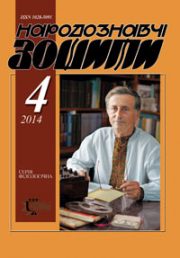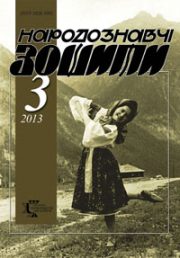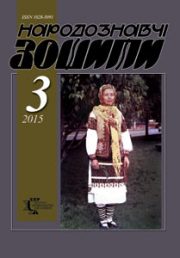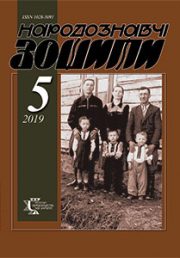The Ethnology Notebooks. 2019, № 5 (149), 1205—1210
UDK 801.631.5:398.8:7.041](100)
DOI https://doi.org/10.15407/nz2019.05.1205
HYPERBOLIZATION IN A POETIC CALENDAR-RITUAL PICTURE OF THE WORLD
KOVAL Halyna
ORCID ID: https://orcid.org/0000-0002-2998-2357
candidate of Philological Sciences (PhD),
Senior Researcher at Folklore Department,
Institute of Ethnography of National
Academy of Sciences of Ukraine,
15, Svobody Avenue, 79000, Lviv, Ukraine
e-mail: galyna.kov@gmail.com
Abstract. The article reveals a poetic tool — hyperbole (exaggeration), which helps to magnify the lyrical hero brighter in order to demonstrate the power of feelings and the depth of emotions. The aforementioned artistic path is more common for lyric-epic folklore (descriptions of the heroes’ appearance, their power, feats), it is also widespread in calendar and ritual songs for depicting features of a portrait, human actions, behavior or processes related to human`s activities. Hyperbole as a certain convention is aimed to express the artistic image and reveal the emotional-aesthetic attitude to it.
Not only persons but also objects surrounding them or belonging to them, as well as all the environment are hyperbolized. Since folklore is the art of words, emotions are important indeed, especially since calendar-ritual songs are directed towards people for the purpose of their exaltation and idealization. Exaggeration concerns especially the owner, the mistress, the guy, the girl who is primarily depicted in Christmas carols.
Hyperbolized in a poetic calendar-ritual senses of happiness and well-being are far from reality, it transports a person into the sphere of a dreamy, fantastic ideal, but they are still realistic in their basis. Their realism is traced in the fact that they consider the daily problems of life, express the agricultural worldview, ethical and aesthetic preferences of the peasants, glorify the man of work with his everyday thoughts and interests, his earthly desires and dreams, sincere feelings and emotions. Creating such a world of images and concepts with the help of hyperbole, folk song goes beyond the real world, represents the desirable objects. In Christmas carols and carol of the bells the perfect and even ideal future is depicted; heroes, as the bearers of tradition are poeticized and become perfect.
The ritual songs reflect the mental essence of man. It is a wealthy master, a hard-working hostess, a brave young son, a pretty and smart girl, daughter for Ukrainians. In these images the codes of national thinking are enshrined, the disclosure of which is facilitated by an artistic tool, such as exaggeration of characteristic properties, signs of a certain object, phenomenon, actions for the purpose of their expression, as well as the expression of emotional-aesthetic attitude to them.
Keywords: hyperbole, exaggeration, artistic tool, calendar-ritual songs.
Received 9.10.2019
REFERENСЕS
Timchenko, V.D. (1988). Hyperbole. Ukrainian literary encyclopedia (Vol. 1, p. 424). Kyiv [in Ukrainian].
Potebnia, O. (1985). Slovenian aesthetics and poetics. Kyiv: Mystetstvo [in Ukrainian].
Hrushevskyi, M. (1993). The History of Ukrainian Literature (Vol. 1). Kyiv: Lybid’ [in krainian].
Sokil, V. (Ed.). (2003). Folk songs from I. Franko motherland. Lviv: Kameniar [in Ukrainian].
Malynka, A.N. (Ed.). (1902). Collection of materials on lesser folklore. Chernyhov [in Russian].
Dubravyn, V.V. (Ed.). (2005). Ritual songs of Slobozhanshchyna (Sumy region). Sumy: Universal’na knyha [in Ukrainian].
Sokil, V., & Sokil, H. (Eds.). (1998). Folk materials from the motherland. Lviv [in Ukrainian].
Potebnia, A.A. (2000). About the mythical significance of some rituals and beliefs. In A.A. Potebnya. Symbol and myth in folk culture. Moskva [in Russian].
Dej, O.I. (1965). Christmas carols and generosity. Winter ritual poetry of the working year. Kyiv [in Ukrainian].
Chebanyuk, O.Yu. (Ed.). (1987). Calendar-ritual songs. Kyiv: Dnipro [in Ukrainian].
Records from the First Field Folklore Tour of the Lviv Department of the Institute of Ukrainian Folklore. 1940. Rozdolsky O.I. Scientific archival funds of manuscripts and phonograms M. Rylsky National Academy of Sciences of Ukraine [in Ukrainian].
Dej, O.I. (Ed.). (1963). Games and songs: spring-summer poetry of the working year. Kyiv: Scientific thought [in Ukrainian].
Proceedings of the ethnographic-statistical expedition in the West-Russian region equipped by the Imperial Russian geographical society. Southwest Department. Materials and research, assembl. P.P. Chubinsky. (1872). (Vol. 3). Sankt-Peterburh [in Russian].
Krut, Yu. (1973). Worship and wishes in ritual poetry of Slavs. In The development and interrelation of genres of Slavic folklore (pp. 91—139). Kyiv: Scientific thought [in Ukrainian].
Franko, I. (1902). Foreword to the publication «Choice of recitation for Russian peasants and burghers». Lviv: Enlightenment. In I. Franko. Collection of works: in 50 vol. (Vol. 33). Kyiv: Scientific Thought, 1982 [in Ukrainian].
Nabok, M. (2014). Ukrainian folk thoughts: features of national character and typology of the hero. Ternopil [in Ukrainian].
Hrynchenko, B.D. (1899). Ethnographic materials collected in Chernihiv and neighboring provinces (Vol. 3). Chernigov [in Ukrainian].
Semenenko, V.P. (2006). It is poetic to model the beautiful in Ukrainian folklore: a traditional idea. Abstract … cand. fіl. [in Ukrainian].







